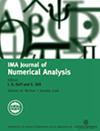Stability estimates of Nyström discretizations of Helmholtz decomposition boundary integral equation formulations for the solution of Navier scattering problems in two dimensions with Dirichlet boundary conditions
IF 2.4
2区 数学
Q1 MATHEMATICS, APPLIED
引用次数: 0
Abstract
Helmholtz decompositions of elastic fields is a common approach for the solution of Navier scattering problems. Used in the context of boundary integral equations (BIE), this approach affords solutions of Navier problems via the simpler Helmholtz boundary integral operators (BIOs). Approximations of Helmholtz Dirichlet-to-Neumann (DtN) can be employed within a regularizing combined field strategy to deliver BIE formulations of the second kind for the solution of Navier scattering problems in two dimensions with Dirichlet boundary conditions, at least in the case of smooth boundaries. Unlike the case of scattering and transmission Helmholtz problems, the approximations of the DtN maps we use in the Helmholtz decomposition BIE in the Navier case require incorporation of lower order terms in their pseudodifferential asymptotic expansions. The presence of these lower order terms in the Navier regularized BIE formulations complicates the stability analysis of their Nyström discretizations in the framework of global trigonometric interpolation and the Kussmaul–Martensen kernel singularity splitting strategy. The main difficulty stems from compositions of pseudodifferential operators of opposite orders, whose Nyström discretization must be performed with care via pseudodifferential expansions beyond the principal symbol. The error analysis is significantly simpler in the case of arclength boundary parametrizations and considerably more involved in the case of general smooth parametrizations that are typically encountered in the description of one-dimensional closed curves.尼斯特伦离散化亥姆霍兹分解边界积分方程公式的稳定性估计,用于解决二维纳维散射问题(带德里赫特边界条件)
弹性场的亥姆霍兹分解是解决纳维散射问题的常用方法。在边界积分方程(BIE)的背景下,这种方法通过更简单的亥姆霍兹边界积分算子(BIO)来求解纳维问题。亥姆霍兹狄利克特到诺伊曼(DtN)的近似值可在正则化组合场策略中使用,以提供第二种 BIE 公式,用于求解具有狄利克特边界条件的二维纳维散射问题,至少在光滑边界的情况下是如此。与散射和透射亥姆霍兹问题不同,我们在纳维散射问题的亥姆霍兹分解 BIE 中使用的 DtN 映射近似值需要在其伪微分渐近展开中加入低阶项。Navier 正则化 BIE 公式中这些低阶项的存在,使得在全局三角插值和 Kussmaul-Martensen 内核奇点分割策略框架下对其 Nyström 离散化进行稳定性分析变得复杂。主要困难源于相反阶数的伪微分算子的组合,必须通过主符号之外的伪微分展开谨慎地对其进行奈斯特伦离散化。对于 arclength 边界参数化的情况,误差分析要简单得多,而对于一般光滑参数化的情况,误差分析要复杂得多。
本文章由计算机程序翻译,如有差异,请以英文原文为准。
求助全文
约1分钟内获得全文
求助全文
来源期刊
CiteScore
5.30
自引率
4.80%
发文量
79
审稿时长
6-12 weeks
期刊介绍:
The IMA Journal of Numerical Analysis (IMAJNA) publishes original contributions to all fields of numerical analysis; articles will be accepted which treat the theory, development or use of practical algorithms and interactions between these aspects. Occasional survey articles are also published.

 求助内容:
求助内容: 应助结果提醒方式:
应助结果提醒方式:


